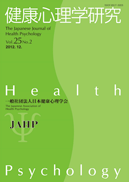All issues

Successor
Volume 9 (1996)
- Issue 2 Pages 1-
- Issue 1 Pages 1-
Volume 9, Issue 1
Displaying 1-3 of 3 articles from this issue
- |<
- <
- 1
- >
- >|
-
Masao Suzuki1996 Volume 9 Issue 1 Pages 1-8
Published: 1996
Released on J-STAGE: April 22, 2015
JOURNAL FREE ACCESSThe present study investigated relationships between the self-evaluations of each parts in the body, depressive mood, the sense of health, and the self-esteem, focusing on the evaluation of posture. We conducted a survey of 332 undergraduate students.
Factor analysis of the results led to identification of the following five factors: (I) mood and sense of health; (II) thickness and profound; (III) length; (IV) bending; (V) state of shoulder. To evaluate the gender difference, a t-test was applied to the self-evaluation of body image. Female students evaluated more bright in facial expression than male students, females were larger than males in hip size, females had thicker legs than males in their leg, their waist and their arm.
Analysis of variance was used for the self-evaluation of posture, the Zung depressive scale, the scale of the sense of health, and the self-esteem scale. The group with the lowest evaluation of their own posture was significantly higher on the Zung depressive scale and lower on the scale of the sense of health than the higher evaluation group.
Self-evaluation of the human body may affect emotions (depressive mood, sense of health, self-esteem) and affect awareness through posture.View full abstractDownload PDF (1131K) -
Tokumi Ueno, Yoshifumi Yamamoto1996 Volume 9 Issue 1 Pages 9-20
Published: 1996
Released on J-STAGE: April 22, 2015
JOURNAL FREE ACCESSThe purpose of this study was to investigate the effect of social support on burnout among nurses. A total of 488 nurses, working at four different hospitals, was surveyed. A modified version of SSQ was used to measure the degree of social support while MBI was used to determine the extent of burnout. The following results were obtained: 1. The major support resources for nurses in their everyday life were the mother, other family members, and the spouses. Co-workers were selected as the main support resource for problems specifically related to difficulties at the workplaces or dealing with nursing in general. 2. There was a positive correlation between the number of network members and the degree of satisfaction with network members. 3. The correlation between number and burnout, as well as that between satisfaction and burnout, was negative. The former was relatively weaker. 4. Nurses who received greater support from their supervisor (leadership M behavior) felt a lesser degree of burnout as did those who established stronger relationships with doctors or patients. Those who believed that patients relied on them extensively showed lower levels of burnout. Each social support variable played a different role in moderating the three component symptoms of burnout-depersonalization, low estimation of personal accomplishment, and emotional exhaustion.View full abstractDownload PDF (1886K) -
Hiroaki Yamada, Osamu Minematsu, Akiko Hiyakawa1996 Volume 9 Issue 1 Pages 21-33
Published: 1996
Released on J-STAGE: April 22, 2015
JOURNAL FREE ACCESSThe concept of psychological or mental positive health equate with self fulfilment, vitality for living, creativity and thriving (Nutbeam, D, 1986). We have previously presented the Psychological Lively Scale (PLS. ver.1) for positive health. This paper describes a revised version of PLS and presents a comparison of PLS on norlmal subjects and patients with mental disorders.
The revised Psychological Lively Scale (PLS ver. 2) consists of 14–items related to positive health and 7–items related to negative health (bad health).
Factor analysis reveals that items of positive health consist of three factors such as “emotional stability”, “fulfilment” and “vitality for living”.
The items of negative health consist of “anxiety”, “depressive mood”, “irritability” and “somatization”. 382 healthy normal adults and 111 patients with mental disorders were compared by PLS(ver.2) in this study.
The results of the above mentioned comparative study are as follows.
1. Average score resulting from the items related to positive health is 37.3±6.1 for normal subjects and 30.7±7.0 for subiects with mental disorders.
2. There are significant differences between normal and mental disorders in three subcategories of positive health.
3. Average score of negative health is 13.8±3.3 for normal subjects and 17.7±4.6 for suttects with mental disorders.
In sum, there are significant differences between normal subjects and subjects with mental disorders in this study. Patients with mental disorders reveal to have a lower positive health and higher negative health according to the Psychological Lively Scale.
The Psychological Lively Scale (ver. 2) makes available to a large number of people a short questionnair to measure vitality for living. The PLS(ver.2) allows a simple inventory of health promotion for a large number of subjects.View full abstractDownload PDF (1556K)
- |<
- <
- 1
- >
- >|